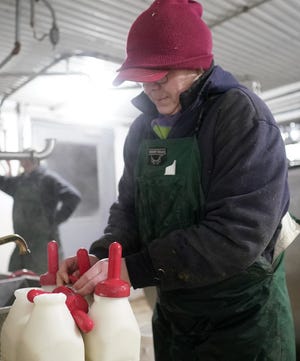Plan to be flexible when bottle feeding calves in cold weather

Like many of you, Thanksgiving was quite different for me and my family this year. I’m afraid a smaller group around the table didn’t mean a smaller calorie intake on my part, however.
It’s that time of year — when keeping your weight in check becomes more challenging!
It’s also the time of year when cold weather conditions affect our outdoor animals’ ability to maintain their body temperature while still growing, gestating or lactating. Of all those animal types, young dairy-breed calves on milk perhaps have the slimmest margin of error to work with regarding the demands of cold temperatures.
Young calves are simply not born with enough internal insulation to keep themselves functioning through long periods of frigid weather. What we do for them during cold weather can mean the difference between a calf that thrives and a calf that becomes chilled, sick and at risk.
While we can do many things to mitigate the effects of cold temperatures on these babies, nutrition is by far the most important consideration. For those lucky calves entering the world this time of year, it starts with colostrum.
We usually think of colostrum for its disease-preventing antibodies, but colostrum is also rich fat and sugars, which provide energy. This first feeding is what enables the calf to start regulating its body temperature. Dairy-breed calves should get at least four quarts of good-quality colostrum within the first 12 hours of life. A cold newborn that does not get colostrum is really behind the eight-ball, as many of you have experienced.
Once on milk replacer, energy in the form of dietary fat is the critical nutrient. Keeping the calf in a positive energy balance is the goal. This happens when the calf takes in more energy than it expends in maintaining body temperature and other functions. In frigid temperature conditions, the normal amount of milk replacer fed (for example, two quarts twice a day) is not enough to maintain a calf in a positive energy balance. So more is needed.
How much more directly depends on the outside temperature. There are tables out there that can help calculate the additional milk needed for a given outside temperature, but a rule of thumb can be helpful: for every air temperature degree below 40 Fahrenheit, one percent more milk should be fed. So if the temperature is 20 degrees Fahrenheit when feeding, 20% more milk should be given for that feeding. If it’s 10 below zero at the time of feeding, that will mean feeding 50% more that day — a whole extra feeding if feeding twice a day. This recommendation generally assumes the calf is dry and protected from wind chill. Further upward adjustments may be needed if that’s not the case.
The temperature of the milk when fed is important too. We should shoot for something near the calf’s body temperature — 102 Fahrenheit — when it hits the calf. This can be a challenge when feeding a long line of calves in freezing temperatures; adjusting the temperature of the mixing water might be necessary, along with monitoring the milk replacer with a good thermometer.
The recommendation to increase the amount of milk fed might seem to fly in the face of another rule I preach — that of avoiding sudden feeding changes with these calves. Work to smooth out those changes by paying attention to long-term forecasts; this will help avoid the gut problems that can result from erratic feeding.
A high-quality milk replacer with at least 20% fat should be used, and the label directions should be followed to the letter. Simply adding more powder to the water used to mix milk replacer is not a good idea; it can cause digestive upsets and possibly clostridium perfringens problems. Encouraging calves to eat starter after a week of age will also aid energy intake; providing free-choice water goes hand-in-hand with this method.
Of course, shelter and bedding become important for calves needing to maintain their body temperature. Insulated barns might seem to be the ultimate solution, but if closed up too tightly in the name of temperature regulation, the resulting ammonia and moisture buildup can cause calf pneumonia.
Calf huts provide good individual environments, but are subject to cold outside temperatures. Providing deep, dry straw helps insulate calves from cold temperatures, but wet bedding actually works to siphon warmth away from calves to the ground below.
Hoping for a warm winter for our calves won’t hurt, but it’s not much of a strategy! On the other hand, building a little flexibility into your feeding program based on Mother Nature can be a good strategy for getting these little ones through a cold winter.

Russ Daly, DVM, is the Extension Veterinarian at South Dakota State University.